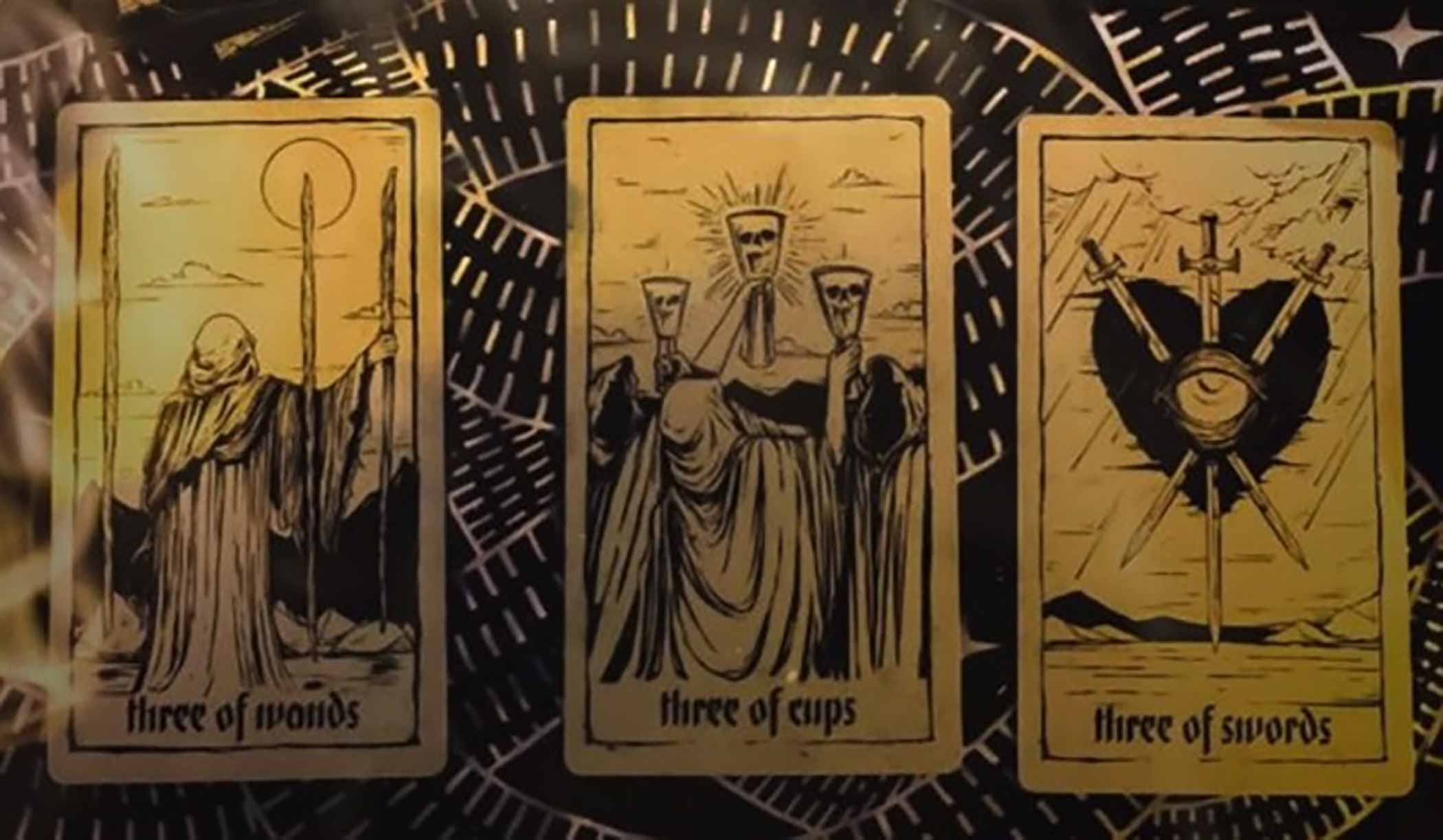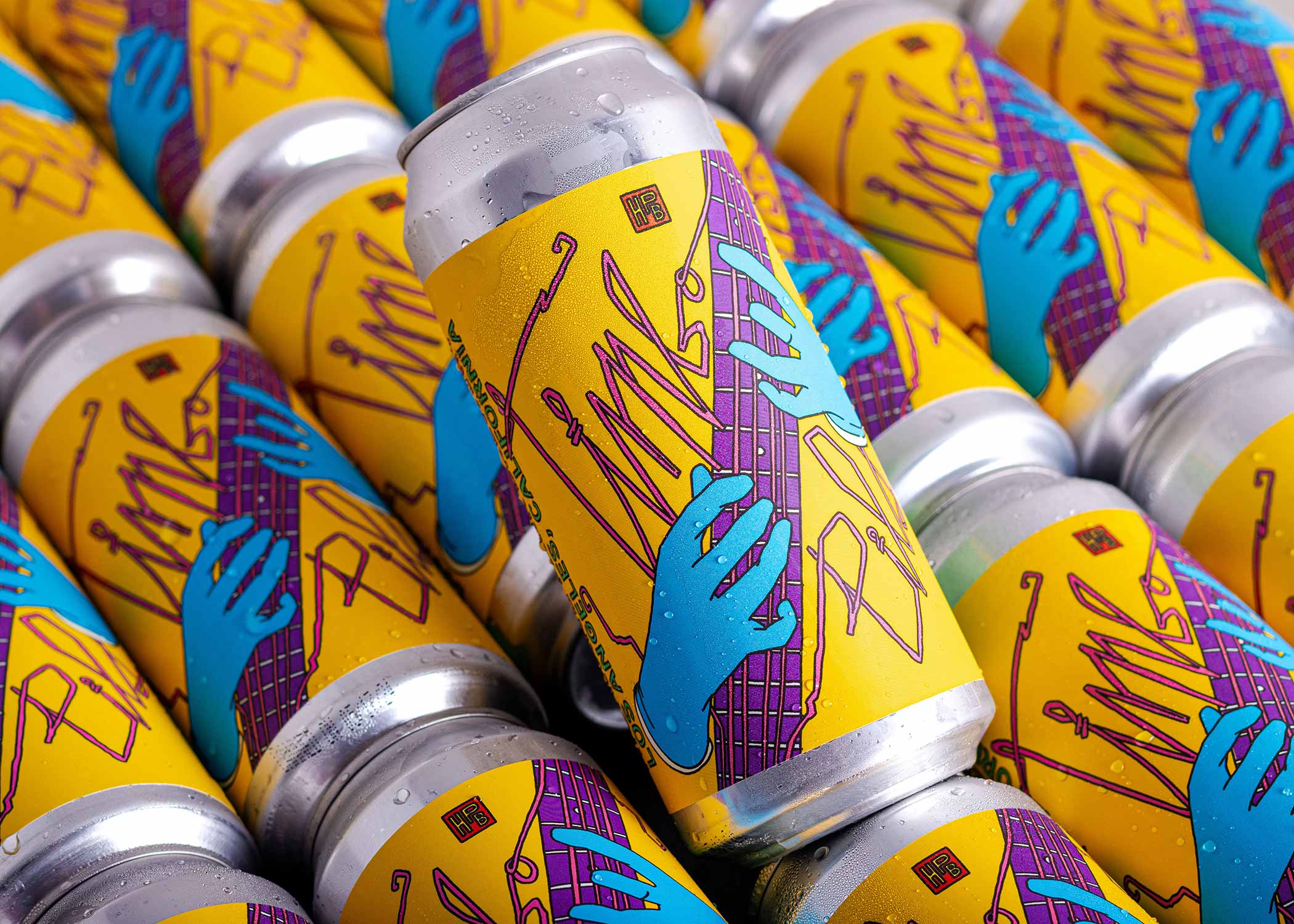Shop
The Three of Cups: Connecting the Dots Between Beer and Tarot
Hottest Summer Stories:
Three hooded figures raise goblets with skull-like faces up towards the sky, shimmering like the waves of a mirage. They seem on the verge of communal cheers, although one could equally interpret them as offering up a sign of thanks. This is the “Three of Cups,” one of seventy-eight cards in a standard Rider-Waite Tarot deck. But this isn’t a card from any standard tarot deck; it’s from TRVE Brewing’s custom-illustrated one.
“Cups is the suit of love, emotions, and relationships,” writes freelancer Courtney Iseman in her zine Beer Tarot, released last year. “The Three of Cups, in particular, speaks to creativity and celebration, with communal vibes of friendship and a celebratory spirit.”
While they may seem like oil and water, beer and tarot are more similar than you might think, with unexpected influences popping up in beer and breweries across the country.
Mystical Art and Science of Beer and Tarot
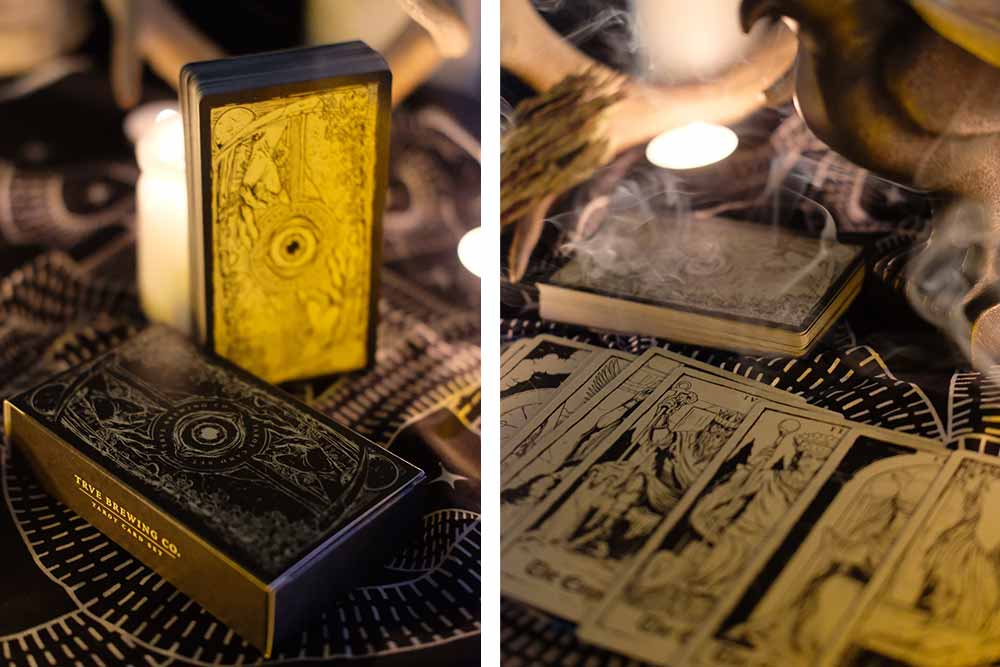
Photography courtesy of TRVE Brewing
Tarot cards aren’t that far off from beermaking. Just think about it for a second. For a long time, cultures that didn’t understand the science behind brewing saw it as almost a mystical art.
“Beer, honestly, before we had the scientific explanation and process, was magic, was mystic,” says Kelsey Seay, taproom manager at 515 Brewing, who is designing her own tarot deck based on the beer industry called The Beer Tarot. “Fermentation itself is pretty magic and was definitely magic to people who didn’t have the scientific explanation for it. So I think that they do go hand in hand a little bit.”
The Czechs, for instance, used to have a saying before they brewed that translated roughly to “God give us luck.” “I think it’s because they didn’t really understand what was working in the 1800s,” Cohesion Co-Founder Eric Larkin told us in another story. “They didn’t know what yeast was; they were just like: I hope this works. It was magical.”
Similarly, for Umqombothi, an Indigenous beer style in many African tribal communities passed down without any written account, beermaking came down to touch and feel rather than science.
“It’s an Indigenous science that has been passed on,” Tolokazi Craft Beer Brewmaster and sorghum beer expert Apiwe Nxusani-Mawela told me. “My mom will tell you that you feel the temperature with your elbow, and by feeling it, you know if it’s too hot or it’s too cold. That’s something that is not written in any book. You just know.”
Tarot similarly converges at the corners of art and analytics.
“Tarot is a really good intersection of some mysticism but also a lot that can be explained by some form of science as well,” explains Seay, who says during readings she looks for insight, not “this is the person you’re going to marry, or this is where you’re going to die.”
Not Your Media’s Mysticism
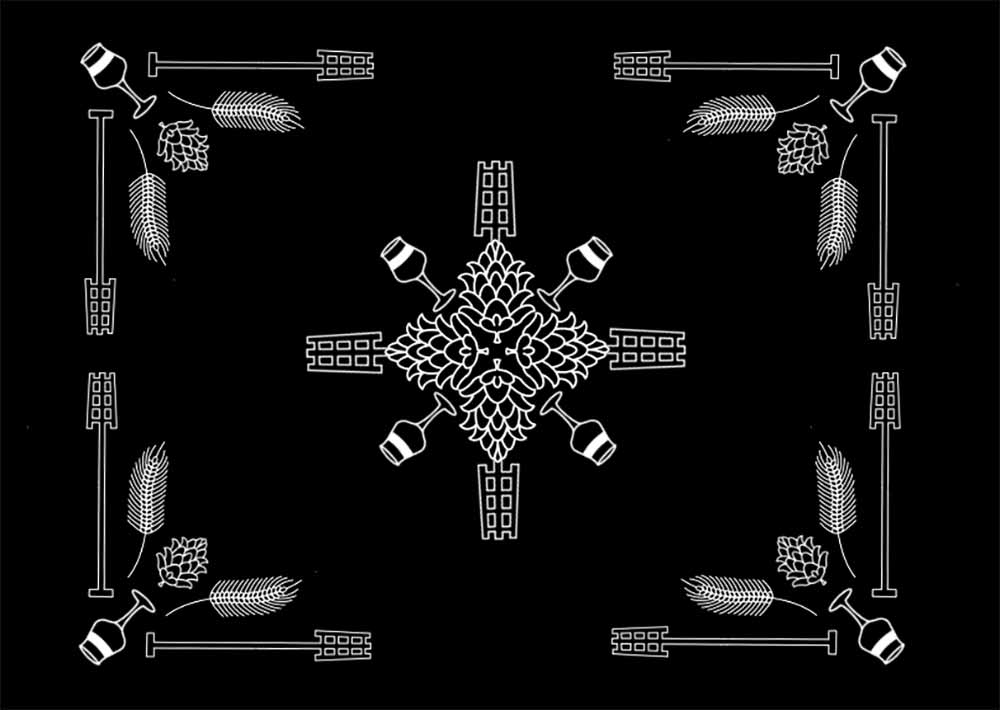
Photography courtesy of Kelsey Seay
Often confused with spookiness, darkness, or reading horoscopes, which “tell” your future, pulling a tarot card is “less trying to predict the future and more let me check in with myself,” explains Iseman, who started tarot while attending a Catholic high school, where she described herself as a goth girl getting into Wicca, “exploring everything that felt not under the Catholic umbrella.
Tarot was one of those things that stuck because it is more about getting in touch with yourself and having a conversation. You can pull a card, and it makes you think about something; it helps you make a decision, so I actually think it’s one of these cool, mystical arts more grounded in reality.”
For those who don’t know (like me before I started writing this piece), tarot cards from the Rider-Waite deck, the most common, well-known, and first ever printed in English, fall into two categories: Minor Arcana and Major Arcana.
The former contains four suits: swords, batons (or wands, clubs, staves), coins (or pentacles), and cups, each with its own meaning. The latter consists of twenty-two different people, such as “The Magician,” “The Priestess,” “The Empress,” and “The Hermit,” each of which has its own meaning. And it’s not usually extremely dire like you’ll see tarot portrayed in mainstream media.
For instance, pulling a death card (also known as “The Hangman”) is “actually one of the most amazing cards,” explains Iseman, “because it means a rebirth is coming, and you might have a fresh start coming.”
When you do a reading, you can “pull” cards in all different ways. “You can wake up every day and just pull one card,” says Iseman. “Some people have a ritual around it, like spreading a special scarf or cloth over the table so the tarot cards aren’t on any surface. You would cut the deck and pull from the top after the cards have been shuffled and rearranged, so that’s your card for the day.”
But you could also just pull a card every day of the week or once a month; it’s a bit up to you.
When you pull a card, you could ask a specific serious question or just query something like what beer you will have at that moment.
Iseman likes to pull one card at a time, or three, asking three questions about a more significant theme. “If you’re making one big decision, like about taking a job, you can ask three smaller questions within that and do a three-card read altogether to help you come up with a decision with a little more clarity,” she explains.
Now, Iseman incorporates tarot into her other hobby and profession—beer.
The beer freelancer, who has published pieces in Food & Wine, Good Beer Hunting, Thrillist, VinePair, Huffington Post, and more, also runs her own newsletter on beer and drinking culture called Hugging the Bar.
Every edition of her newsletter includes a special section.
“What if I pulled a card for each newsletter and captured the vibe of the week in beer,” she explains. “This card comes up; it’s telling you to try something you’ve never tried before, so try a style of beer you’ve never had before.”
Last year, Iseman went even further, teaming up with Bean to Barstool’s David Nilsen and Melinda Guerra to release a zine called Beer Tarot, covering where tarot has shown up in the beer industry.
More and more, we see tarot and beer intersecting.
“Tarot is the theme of all things life, all of your emotions, everything that comes about day to day, and beer is the same way,” says Ben Sitzmann, director of operations and head brewer for a brewery in Le Mars, IA, called Wise I Brewing Company, whose logo and several beers draw inspiration from tarot cards. “It definitely ties in with the history and the elixir of beer. … [But] there are also different ways to look at beer, and there are different ways to look at tarot as well. The meanings behind it, the interpretation is inside you; it’s individualized.”
Just like when you drink a beer, no matter the style, you will interpret it differently than your friend or partner sitting next to you. Each time we sip our drink, we have a different experience. And isn’t that what tarot is all about, too?
For at least some in the beer industry, tarot has become that form of inspiration, connecting the dots between art, science, and something just a little intangible.
The Truth Behind TRVE’s Tarot Deck

Photography courtesy of TRVE Brewing
A brand associated with heavy metal, the darker arts, and divination, TRVE created its own version of a tarot deck last year.
Erin (EJ) Nunns, COO and co-owner of TRVE, saw an opportunity.
“The idea [to make a tarot deck] came from being submerged in TRVE brewing culture—all beer and wonderful witchy friends who surround us—to create something meaningful to them,” says Nunns.
Teaming up with illustrator Max Sherman, TRVE created a hundred of their own custom decks, which all sold out during the release at the brewery, where if you bought a deck, you could sit and have your tarot read.
“Every single one of the cards are individual pieces of art,” Nunns told me.
For instance, the aforementioned Three of Cups (which came up for Nunns at her reading during the release) or the Two of Swords, where a figure with a head made up of a single flame crosses two swords across its hooded body.
Or the Queen of Wands…which Nunns describes simply as “insane.”
Iseman uses TRVE’s deck for every card she pulls for her Hugging the Bar newsletter. “I’m a die-hard fan of the TRVE tarot deck,” she exclaims. The Three of Cups and Two of Swords are two of her favorites.
“The Three of Cups is a card about having an idea, having an inspiration for something, starting some new pursuit, but then, like, getting to work and turning that into something. It’s a really creative card,” Iseman says.
The Two of Swords, on the other hand, comes down to decision-making. “I’m stuck between two beers. What do I want to drink?” explains Iseman. “Or it could be: I don’t know if I want to take this job in a city across the world.” Iseman says this card has been very relevant for her lately. “Craft beer is in a weird place; media is in a weird place,” she says. “What is the next step? How do you survive these industries if you want to stay in them?”
Nunns similarly feels like tarot cards generally have a higher meaning when it comes to beer.
“Beer always wants to know where it is going and pretend like we’re the tastemakers who decide where trends follow,” she says. “But, truth be told, it’s like drawing cards—you’re doing your best and following your instincts.”
She continues. “The deck will tell you something, but it will never tell you everything. It might give you inclinations or things to look out for or follow, but it’s anyone’s guess. It’s been a pretty wild ride to anticipate what’s happening: Will the bubble burst? Will hazy IPAs be over? Does anyone ever want to drink a saison again?”
As Iseman mentioned, when you pull a tarot card, the point is to use that as guidance. It’s not a full-on prediction but a marker to help direct you on your path.
Uncertainty is part of the adventure. “We can try to spend a ton of time guessing what is going to happen, but we really don’t know,” Nunns says. “Deciding how to run a business in the beer industry that will last feels the same as having your tarot read!”
While we don’t know everything, we can tell you another deck is in the cards for TRVE.
Although she couldn’t confirm anything concrete with us at the time of publication, Nunns says they plan to release the same deck or even an updated one in the future.
Amazingly, TRVE isn’t the only one creating tarot decks in the beer industry.
Turning the Ace of Wands Into the Ace of Rakes: The Beer Tarot
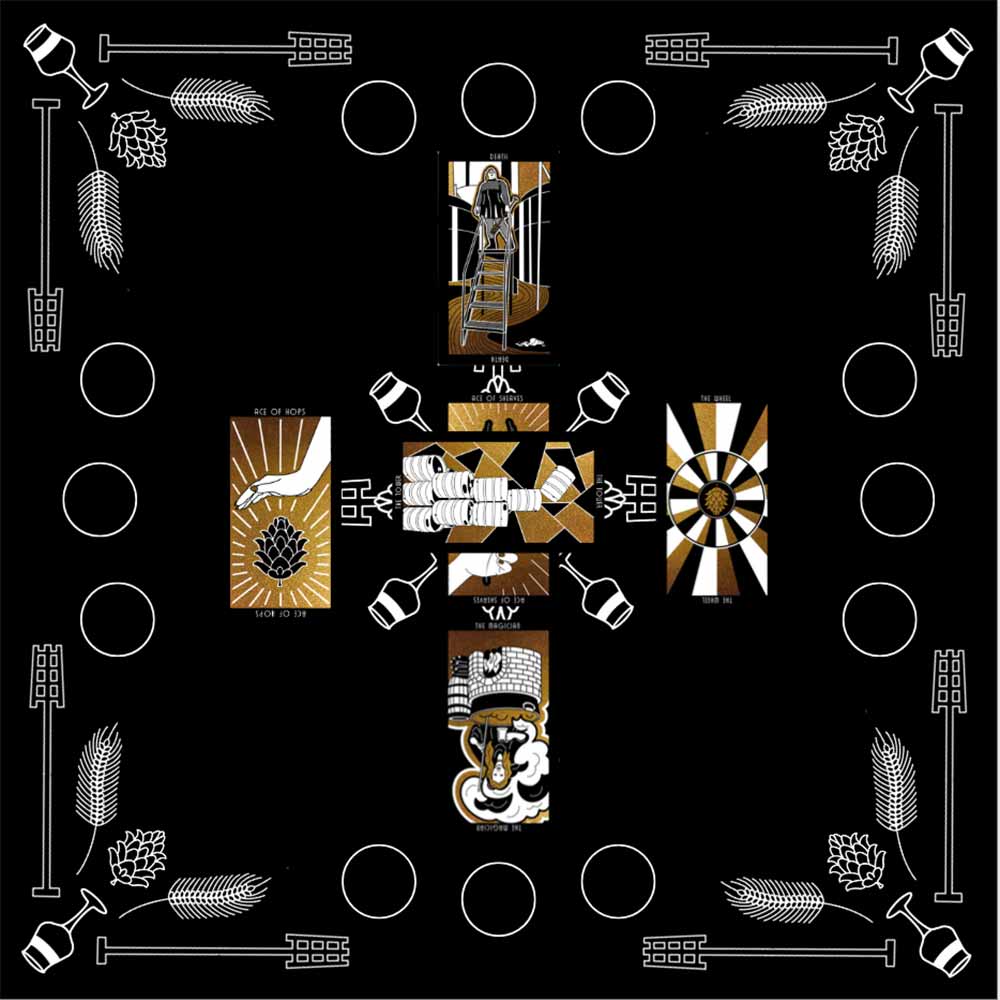
Photography courtesy of Kelsey Seay
While TRVE’s deck didn’t actually feature beer, Kelsey Seay’s deck called The Beer Tarot favors it heavily.
The taproom manager at 515 Brewing and former assistant director at the Iowa Brewers Guild tells me she’s been into tarot cards since high school. “I don’t know if you can tell, but I’ve always been a little witchy,” she says, pointing to her wavy red hair and I-Dream-of-Jeannie-esque pointy black spectacles.
In high school, she pulled cards to see who she might date, but now she seriously collects all kinds of tarot decks.
She reckons she has about fifty, although “I’m sure my husband would say there are probably more than that,” she says with a laugh.
Seay first bought an Art Nouveau deck from Barnes & Noble’s spiritual section. “I got the mini one because I was really excited about it being so small that I could carry it with me,” she explains gleefully.
Now, her collection includes literary decks based on stories, books, novels, and one called Alleyman’s Tarot, an artist-forward deck.
After collecting decks since she was a teenager and working in the hospitality industry for ten-plus years as an adult, Seay had the brilliant idea to illustrate one of her own, incorporating elements of beer.
All the face cards from the Major Arcana—such as the Page, the Knight, the Empress, the Queen, the King, etc.—feature actual faces of people from the beer industry with a focus on women, trans, and non-binary folx, and those from marginalized communities.
For instance, Barb Becker, brewer at 515 Brewing. “She is my Empress,” explains Seay. And while the card isn’t quite finished yet, Seay says her notes for this one include “beauty, fertility, nurturing, luxury, creativity, and we are for sure working in her interest in nurturing yeast babies!”

Photography courtesy of Kelsey Seay
Or Rachel Engle, a trans head brewer at Bosk Brew Works. Seay transposed Engle onto the Death card because, remember, this card signifies rebirth.
“She’s basically on top of a brew system and a little bit of forced perspective where it looks like she’s being elevated,” explains Seay, who illustrated a photo Engle sent her, adding a mash paddle into her hand. “There’s a broken bottle on the ground because that’s the very hard symbolism of death.”
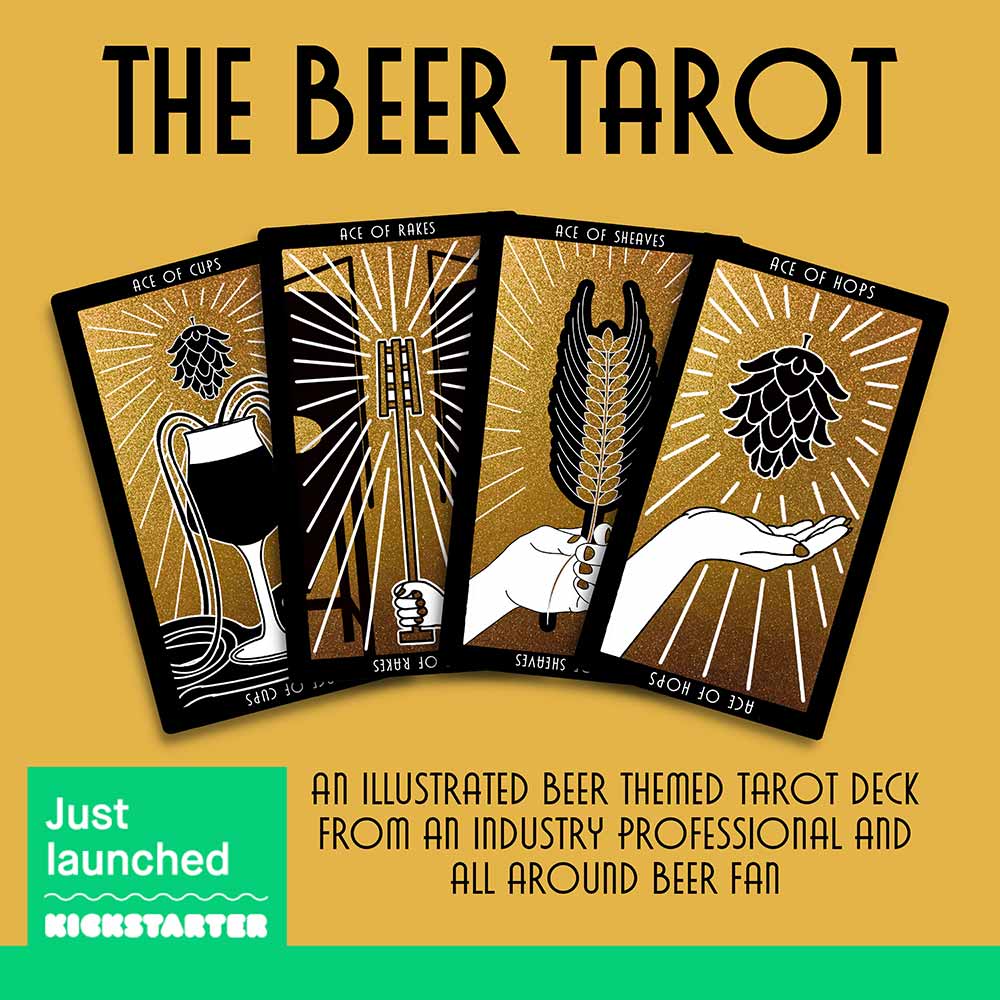
Photography courtesy of Kelsey Seay
For the suits of the Minor Arcana—cups, swords, pentacles (aka coins), and wands (aka clubs and staves)—Seay cleverly and creatively includes hints to brewing.
Cups will obviously stay cups, but swords become sheaves of wheat, and pentacles become hops. In one specific example, the Ace of Wands becomes the Ace of Rakes, featuring a mash paddle.
Seay says wands in a tarot deck are typically depicted as tree branches or even leaves coming out of some clouds. For her version, Seay drew a hand holding a rake with two vats behind it.
She shows me another example from the Major Arcana called The Fool. With the number zero, The Fool depicts someone right at the start of their journey, so Seay drew a homebrew pot, clouds billowing out of the top, to signify where most brewers start.
When Seay finishes The Beer Tarot (she told me she’s aiming for December of this year), the deck will be the first of its kind.
Could it be a sign of more to come?
Editor’s Note: If you’re interested, check out her Kickstarter!
The Hermit: Wise I Brewing Company
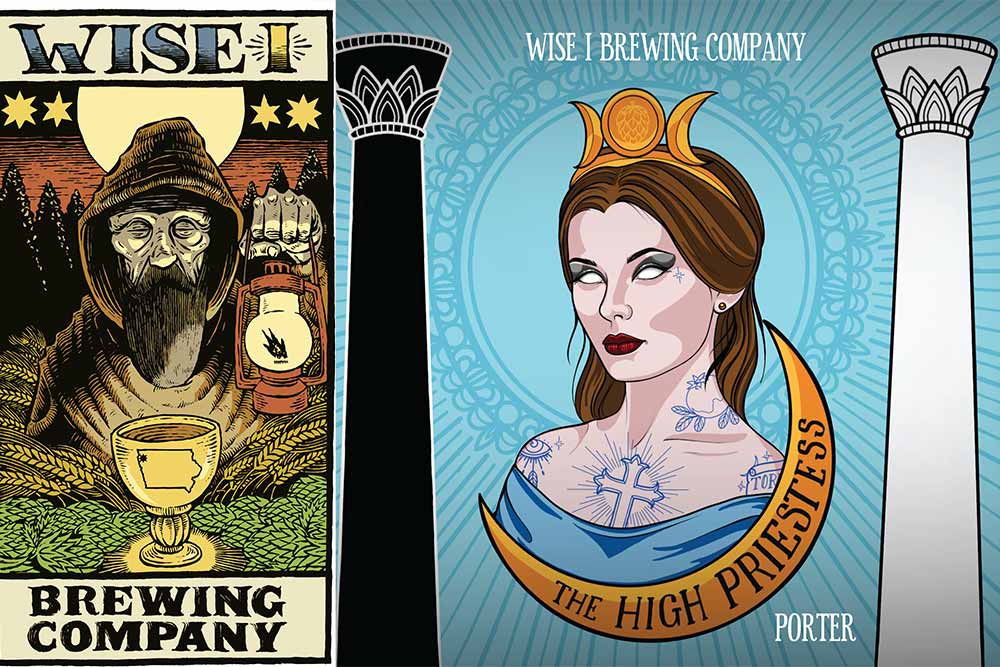
Graphics courtesy of Sam Heimer (on the left) and Jessi Lynch (on the right)
It’s hard to miss Wise I’s tie-in to tarot. Just take a look at their logo and the sign above their door.
The Hermit card inspired the illustration by designer Sam Heimer.
Named after Ida Wise, a historical figure in Iowa and president of the Woman’s Christian Temperance Union from 1933 to 1944, Wise I Brewing wanted its logo to depict a wise person searching for the holy grail, according to Wise I Director of Operations and Head Brewer Ben Sitzmann.
“The Hermit represents wisdom, and it played perfectly with the brewery and how long it takes to think of beers, the business itself, that wisdom,” says Sitzmann, “so it was a perfect combination.”
Sitzmann, who admits he didn’t follow tarot much at the time, has gone down the rabbit hole a bit, naming beers and designing labels off of other tarot cards.
For instance, one of Wise I’s first beers, the High Priestess Porter, is based on the High Priestess card.
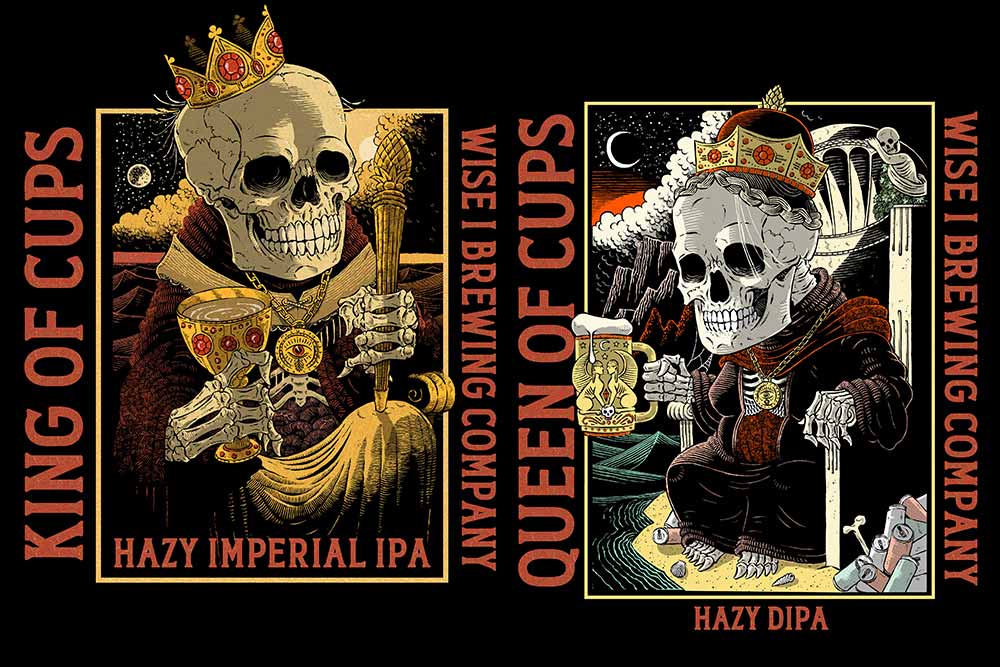
Graphics courtesy of Sam Heimer
And Sitzmann says they themed the entire brewery’s first anniversary around tarot, brewing the King of Cups and the Queen of Cups.
The former is a boozy 10% ABV imperial hazy IPA with Citra, Vic Secret, and Loral. “We wanted it bigger to represent the King,” says Sitzmann. “It’s very juice-forward—almost like boozy OJ.”
On the label, a skeleton, adorned in robes and jewels, clutches a bejeweled goblet and staff with a crown atop its skull.
The Queen of Cups, on the other hand, is “obviously a bit less ABV just for that dynamic of king to the queen,” says Sitzmann. “But it was the first beer we did a mash hop.”
Featuring Citra, Mosaic, and Nelson Sauvin, the hazy is very tropical fruit-forward.
Inspired directly by the tarot card, the Queen of Cups label again features a skeleton with a crown, sitting on a throne holding a beer stein.
“The suit of Cups is perfect because of the beer,” says Sitzmann. “[And] the suit of Cups represent emotions and relationships, which transfer to beer fluidly. Pun intended!”
Sitzmann says there are plans to brew beers based on the Knight, the Page, and the Ace of Cups, too.
And Wise I isn’t the only brewery to draw inspiration from tarot. Brasserie L’Hermitage in Brussels, Belgium, draws heavily on different tarot cards to name its beers and design its labels, and the New Belgium Summer Solstice lineup last year included three beers based on three tarot cards—The Sun, The Empress, and The Ace of Globes.
Fortune Favors the Beer
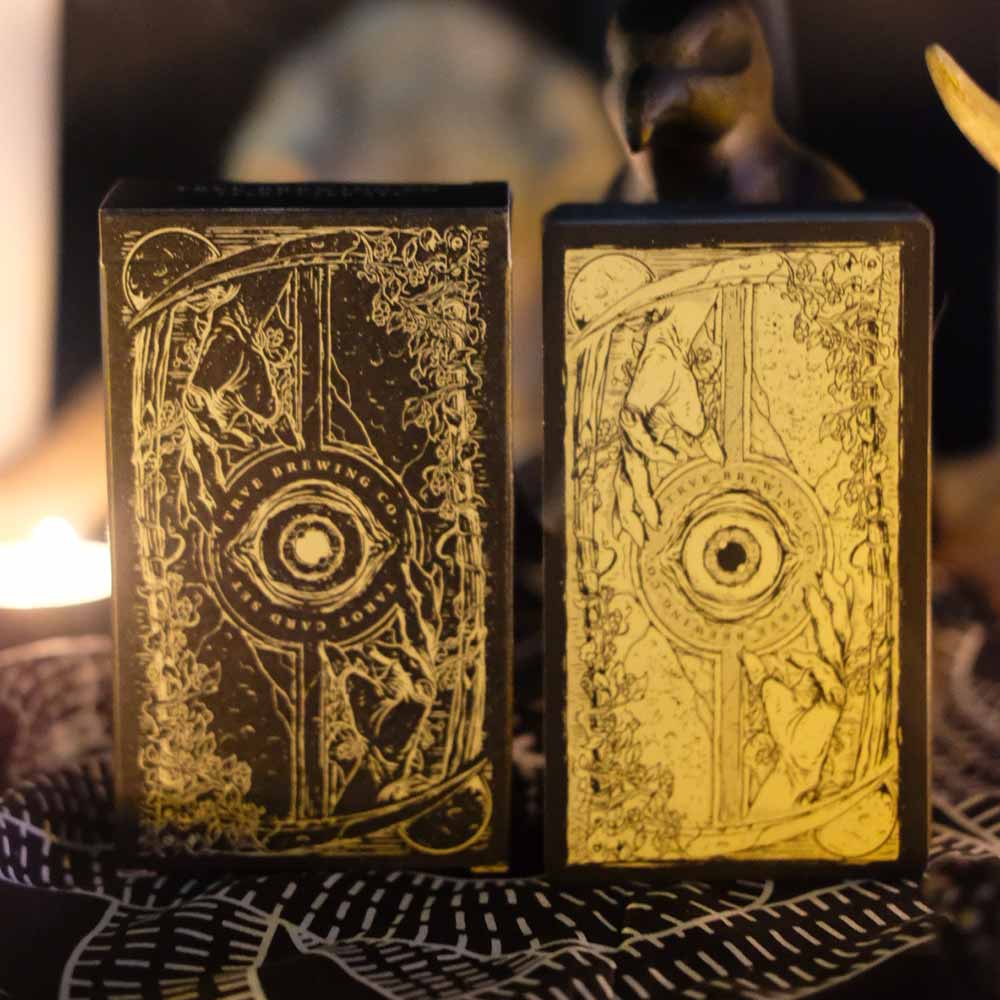
Photography courtesy of TRVE Brewing
Our future, the beer industry’s future—it’s all unknown.
But for those like Iseman, Seay, Nunns, and Sitzmann, who find beer and tarot intertwining, they’re not alone.
From custom beer decks to labels, beer, and brewery names, tarot has surprisingly wound its way into our own mystical liquid arts, whether you realize it or not.
“I do like to see that tarot is being looked at because there are a lot of people who use it, and I think it is important for people to start to realize, oh, it’s not scary,” says Seay. “I’m excited!”

